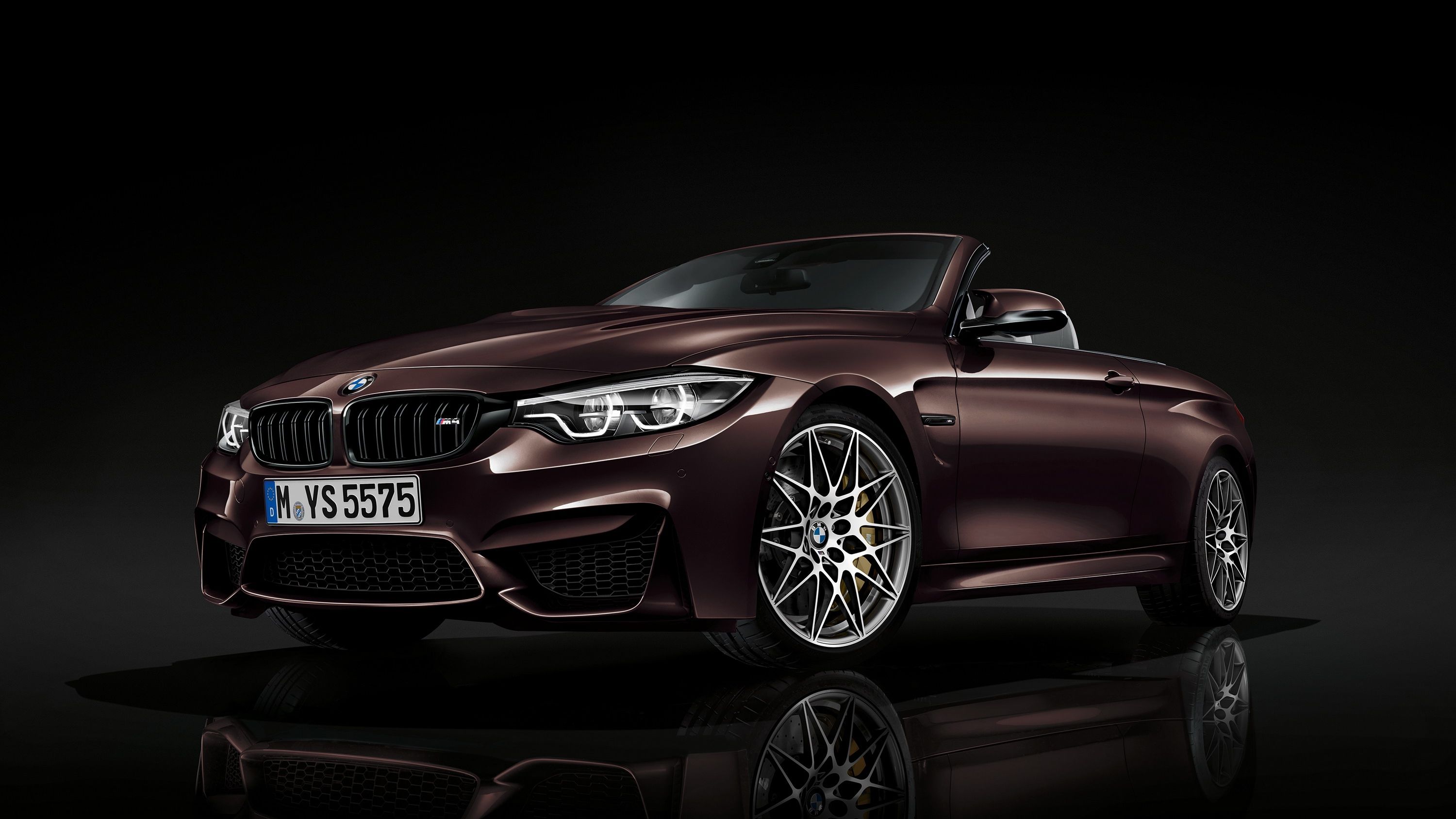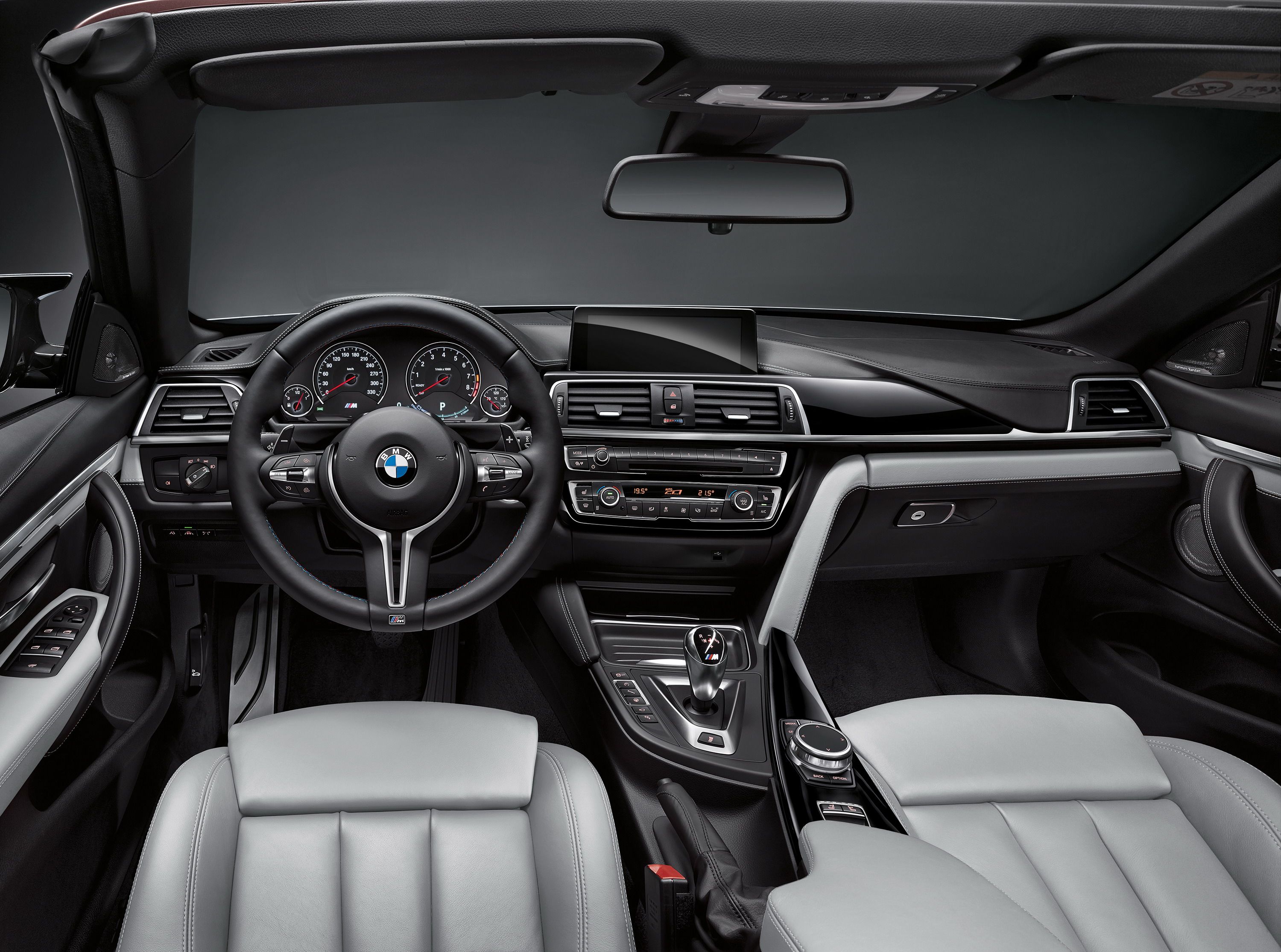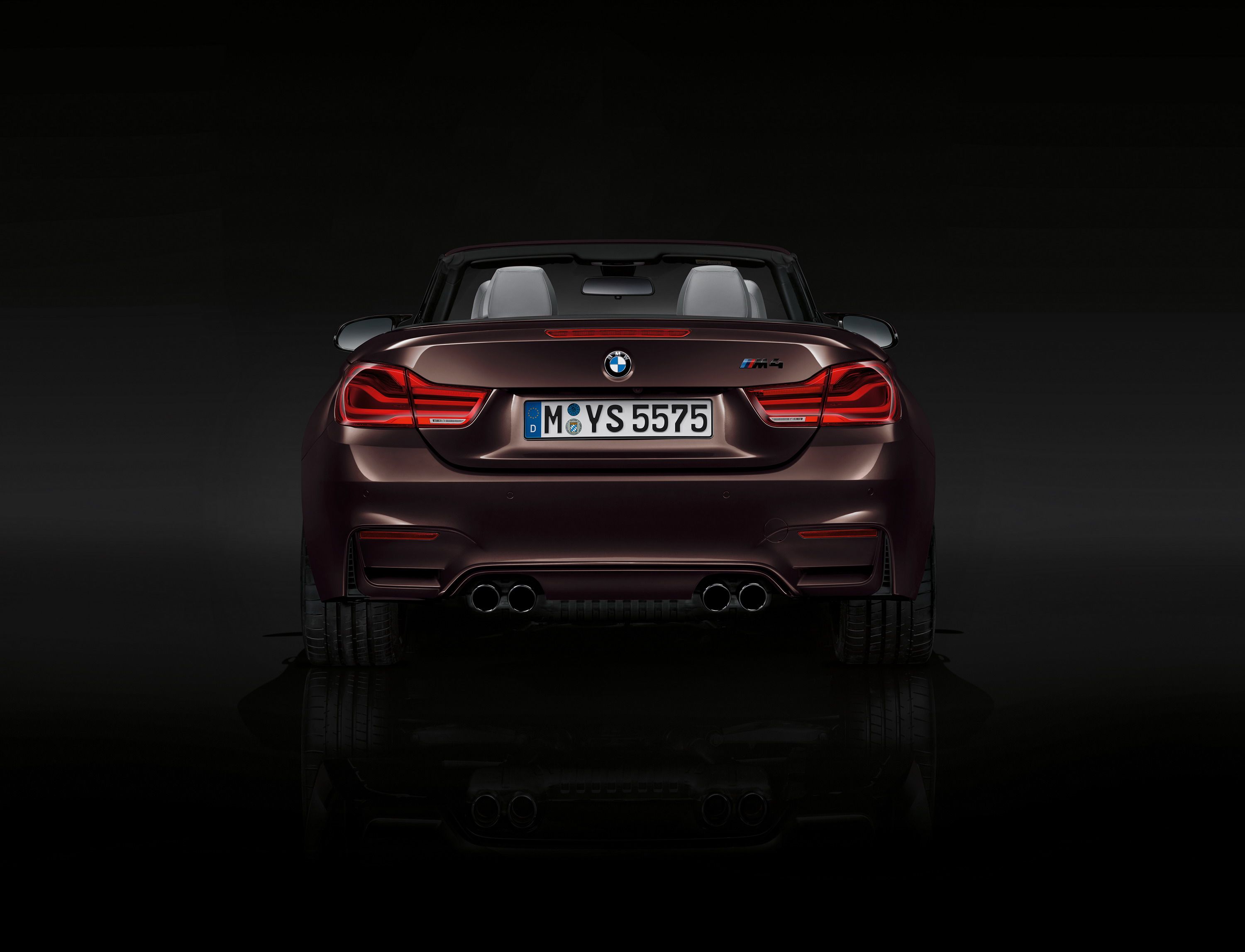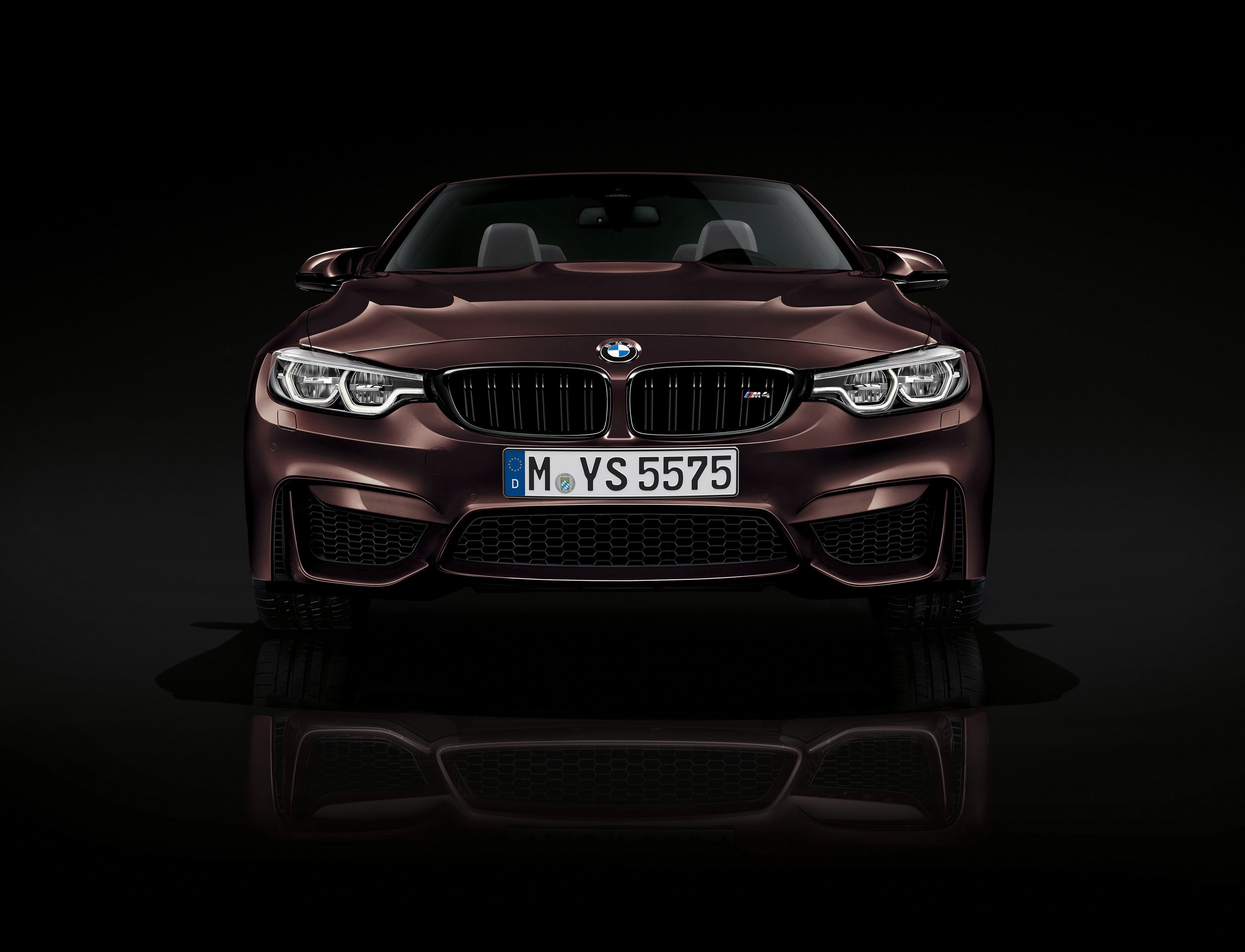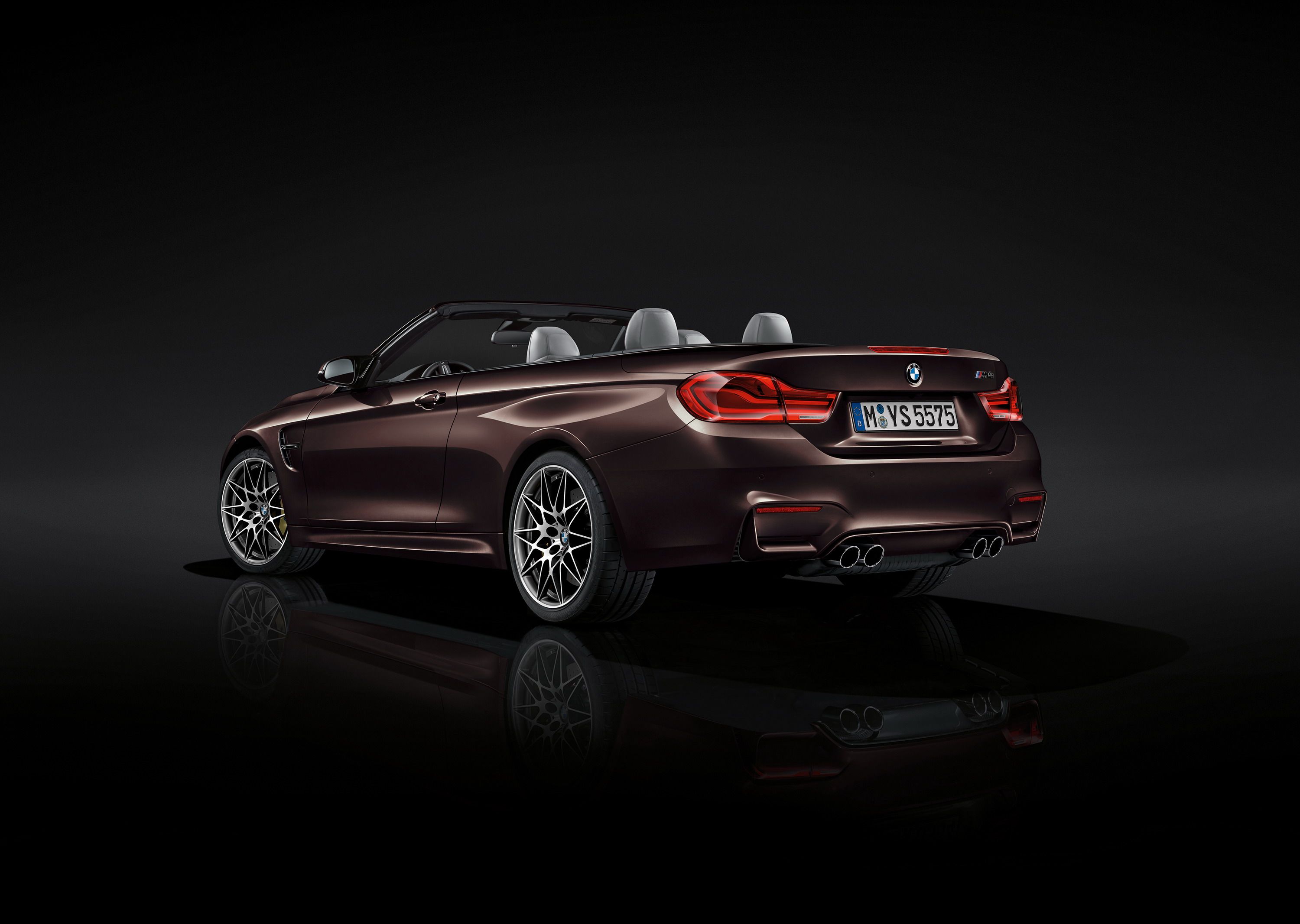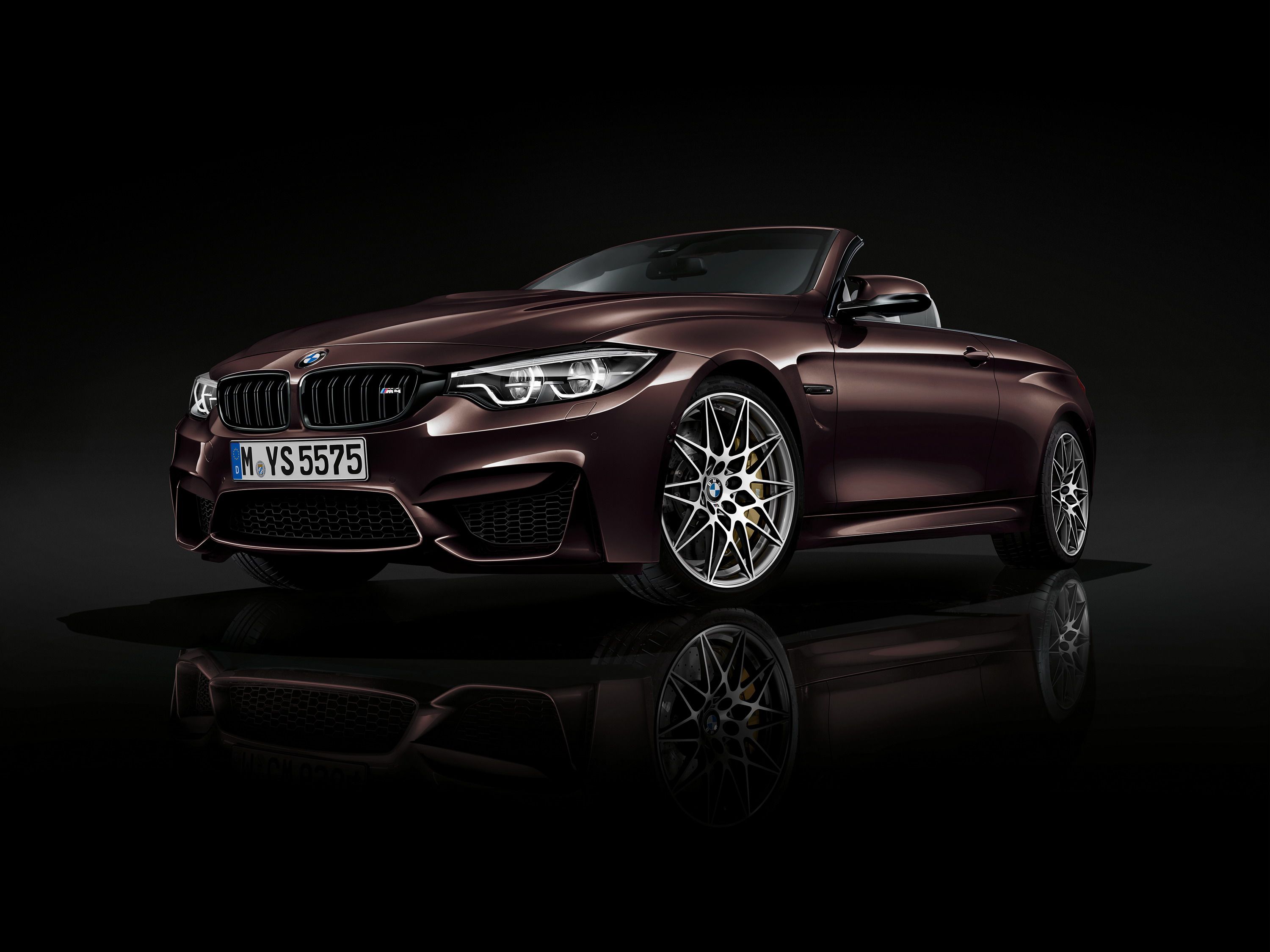When BMW rolled out the M4 at the 2014 New York Auto Show, it represented the culmination of the 3 Series splitting into two distinct models. The four-door sedan version and all of its derivatives still carried the 3 Series name, but the sportier two-door variant was renamed the the 4 Series. The latter then gave birth to the M4 performance coupe, and three years after the first M4 burst into the scene and into our welcoming arms, BMW has finally announced an update to the coupe that has turned into one BMW’s most popular models.
Like with most updated models, the M4 Convertible remains the same, at least for the most part. The convertible’s design hasn’t changed, specifically in the front and rear fascias. That said, this isn’t the same exact M4 Convertibles either. There are upgrades in place all over the car that help distinguish it from its predecessor. Some are more obvious than others, but the objectives of freshening up the M4 Convertible for a plate of new customers are all there.
So if you’re in the market for a convertible that’s getting some nice new bits and pieces here and there, the updated BMW M4 Convertible makes for a pretty compelling option. Not only does it exude the confidence and outright braggadocio of BMW’s M Division, it’s also turned itself into the face of that same division. Now that same face just got a fresh set of updates. It seems to me at least that the good just got better.
Continue after the jump to read more about the BMW M4 Convertible.
2018 BMW M4 Convertible
- Make: Array
- Model: 2018 BMW M4 Convertible
- [do not use] Vehicle Model: Array
Exterior
Ok, we’ve established that the 2018 BMW M4 Convertible is not a new model. It’s been around since 2014, but it’s only now that the car is getting an update. Even then, the term “update” is subjective. Other updates offer significant upgrades whereas others barely have any differences in them other than a cosmetic tweak here or an aesthetic tuck there.
The 2018 BMW M4 Convertible falls somewhere in the middle. It’s still largely the same model since the front and rear fascias are the same, as is the side profile. Even BMW’s iconic kidney grille remains the same, a staple for all models that fall under the German automaker’s name. Unless you’re a stickler for details, it’s going to be difficult to find significant changes to the updated M4 Convertible.
That said, if you are that stickler, you should be able to notice the changes that BMW made to the M4 Convertible. First up are the headlights, particularly those sexy LEDs that now come as standard on all M4 Convertible models. In addition, the Icon Adaptive LED headlights with those hexagonal graphics are now available as options in case those standards LEDs aren’t working for you.
For the most part though, the updated M4 Convertible is largely defined by the lot of new accessories and packages that BMW has on offer for the sporty drop-top. Yep, those who have been pining for some M Performance goodies on the BMW M4 should be thrilled to know that their wishes have been granted. For the first time since the German automaker split the 3 Series to create the 4 Series, BMW’s M Performance Accessories are now available as added options. There’s the Exterior Carbon package, which adds carbon styling components to the M4’s overall look. The front and lower trims, in particular, are worthy additions to the M4 Convertible. The same can be said for the new spoiler and rear diffuser,both of which are made from carbon fiber. Another package that’s now available for the M4 Convertible is the Carbon Mirror package, which, as the name so predictably suggests, comes with carbon fiber mirrors.
Those who opt for some upgrades to the M4 Convertible’s wheelers have the Competition package to look into. Not only does it provide the traditional high-gloss black exterior components, it also has a new set of 20-inch, forged light alloy wheels that are designed in a star-spoke 666 M style. And as a final piece of touch, BMW is also offering a Black Exterior package that’s made up of black kidney grilles, side bars and exhaust tips.
Lining up the BM4’s exterior against its rivals.
Let’s get this out of the way. Any mention of a BMW model inevitably follows with a response of a Mercedes model. That’s the case with the BMW M4 because ultimately, the Mercedes-AMG C63 measures up against it in a lot of ways. The same can be said for their convertible counterparts as the AMG C63 Cabriolet poses the most legitimate threat to the success of the BMW M4 Convertible.
The newest version of the AMG C63 Cabriolet was unveiled at the 2016 New York Auto Show last April. Just like with the M4 Convertible, there wasn’t really a shroud of mystery surrounding the Mercedes drop-top since expectations called for it to closely resemble the design of its coupe counterpart. On that end, Mercedes-AMG followed that script, right down to the most specific of nuances. One of the biggest takeaways from the AMG C63 Cabriolet was how bigger and stouter it looked compared to the coupe version. It may not seem much to the naked eye, but those front wheel arches, for example, account for an extra 2.5 inches in width. It’s the same story with the rear arches adding 2.6 inches to the measurements of the cabriolet. Those extra inches should also have some effects on size comparisons between the M4 Convertible since the model, as well as the AMG C63 and the M4 Coupe actually have the same width measurements at 73.6 inches. If the updated M4 Convertible maintains the same measurement, the AMG C63 Cabriolet would be wider than its BMW rival.
Move past the measurements and you’ll also notice some unmistakable Mercedes trademarks, not the least of which is the automaker’s twin-blade radiator grille that flank the iconic three-pointed star logo. The “A-wing” bumper is another particularly prominent design detail among Mercedes models. No surprise then that the AMG C63 has it too. Likewise, the Mercedes also has a more muscular-looking hood, highlighted by those distinctive character lines that run almost the length of the whole panel. Move to the side and and you see the same character lines that can be found on the AMG C63 Coupe. I’ve always believed that these lines have more important roles on convertible models compared to coupes. That’s because the absence of hardtop roofs immediately turns people’s attention to the body and how these lines run can help create the physical character of these convertible models. You can see it in both the AMG C63 Cabriolet and the M4 Convertible.
From there, we move to the rear section of the AMG C63 Cabriolet. Predictably, there weren’t a lot of dramatic changes either compared to the coupe model. The rounded tail is still there, as are the slim taillights. Mercedes has always taken pride on being a little less understated than BMW and that philosophy is apparent here. There’s a minimalist look to the AMG C63 Cabriolet’s look that can be described as classy and elegant. Compare it to the busier appearance of the M4 Convertible and that in itself creates a big styling differentiation between the two models.
Note: Discontinued Audi RS5 Cabriolet
To be clear, there is no Audi RS5 Cabriolet that’s out on the market these days. The model, after all, was discontinued back in 2013 and it hasn’t been back since. But I’m including the RS5 Cabriolet here because a new version is expected to arrive soon – possibly as early as next year – and once it does, it’s going to be a direct rival to the BMW M4 Convertible and the Mercedes-AMG C63 Cabriolet.
Based on what we know at this point, the RS5 Cabriolet will heavily lean on the design of the Audi Prologue Concept. Knowing this at least gives as an idea on what the two-door convertible could look like, particularly in the case of its front and rear sections. The first thing we thought of was how Audi would adapt its current design philosophy on the car and if it follows that same template, the RS5 Cabriolet could have a lower and wider stance than both the BMW M4 Convertible and the Mercedes-AMG C63 Cabriolet. Notice how prominent the shoulder line dip is at the front? The angular headlights help mask that design, but when you also add the sloping hood with the prominent lines into the equation, the front section of the RS5 Cabriolet, or at least our interpretation of it, looks more naturally like a performance sports car than its counterparts from BMW and Mercedes-AMG.
2018 Audi RS5 Cabriolet TopSpeed rendering
The aforementioned shoulder line of the RS5 Cabriolet also extends almost the whole length of the car, helping enhance the flared appearance of the car. It’s also worth noting that the RS5 could end up being the only one of these three models with a prominently raked lower character line. Both the M4 Convertible and the AMG C63 Cabriolet have them too, but theirs are a little more subtle than the RS5 Cabriolet.
In typical Audi fashion, we can also expect the returning RS5 Cabriolet to feature the automaker’s traditional headlights configuration. Who knows, Audi could even go so far as to use its new laser light technology on the model. Don’t sleep on that happening, especially if the new tech is embraced as much as it should in the automaker’s biggest markets.
Exterior Dimensions
|
Audi RS5 Cabriolet |
Mercedes-AMG C63 Cabriolet |
BMW M4 Convertible |
|
|
Wheelbase (Inches) |
108.3 |
111.8 |
110.7 |
|
Length (Inches) |
183 |
187.0 |
184.5 |
|
Width (Inches) |
73.2 |
73.9 |
73.6 |
|
Height (Inches) |
53.8 |
55.5 |
54.6 |
|
Track Width front/rear (Inches) |
62.3/62.0 |
64.4/62.7 |
62.2/63.1 |
Interior
Just like the exterior of the updated BMW M4 Convertible, the interior benefits from a number of new bits and pieces, but for the most part, the whole environment of the cabin largely retains its stock configuration. On the cosmetic side, prominent updates include new illuminated M4 emblems on the front seats and some fancy new double stitching on the instrument panel that not only provides a nice departure from its previous iteration, but it also makes for a cleaner looking dashboard. Chrome or electroplated finishes are also welcome additions to the M4 Convertible. The former, in particular, is generously distributed on the steering wheel, along the nose of the dash, around the HVAC vents, and on the center stack while the latter can be seen on the long trim strip that runs the entire width of the dash.
They’re all very subdued upgrades by themselves and more often than not, some owners don’t even notice them. But when you put them all together, they become more distinctive and they contribute in creating a refined look to the cabin.
Packages and added accessories are also a common sight among new BMWs. The M4 Convertible is no different as BMW has on offer a Carbon Interior package that includes the installation of an Alcantara steering wheel with its own carbon fiber inlays and a gear surround and selector that’s dressed in a clean carbon fiber finish.
On the technological side of things, the M4 Convertible also benefits from getting an updated infotainment system that includes among other things, a new interface that features rearrangeable, tile-style control pads, as well as an optional Multifunctional Instrument Display that allows drivers to choose from a number of different visual options for the display. The M4 Convertible also gets other standard options, including the Professional navigation system with its own new user interface, ConnectedDrive services and enhanced Bluetooth, complete with inductive charging of mobile phones and a Wi-Fi hotspot.
Apart from these changes and updates, the M4 Convertible’s interior still imbibes the same familiarity that we’ve seen from it since its debut in 2014. Hardly a surprise then that for an updated model – not an all-new one – the changes made to the cabin fall more on the conservative side.
What have the rivals done?
Unlike the numbers-based differences in engine size, power, and performance, the differences in choosing which interior is the best boils down to subjective preference. Some would-be customers might prefer the M4 Convertible’s more functionalized interior whereas others might opt for the cleaner-looking, yet no less functional cabin of the Mercedes-AMG C63 Cabriolet.
Here’s a little trick to understanding the importance of a pleasant interior. You know how important a car’s exterior physical appearance is, but the importance in that hinges on how other people see it, whether they’re close to the car or are looking at it from a distance. By contrast, that same car’s interior is not for other people; it’s specifically for the driver and his passengers. Look at it this way: when you’re driving a car like the BMW M4 Convertible, you can’t see what it looks like from the outside. But because you spend literally all of your time inside your car when you’re driving it, the importance of an aesthetically pleasing cabin is emphasised even further because that’s the only thing you see other than the road ahead.
That’s a big reason why the interior of the Mercedes-AMG C63 Cabriolet is one of the car’s strongest features. It’s an absolute delight to look at. Of all the cars in this segment, the M4 Convertible included, the AMG C63 Cabriolet succeeds the most in creating a versatile-looking interior that caters to a lot of tastes and preferences. It’s stylish and classy to the point that you’re constantly reminded that you’re in a Mercedes. Premium materials like leather, microfibre, and aluminium are generously used throughout the cabin. It also has a number of refined cabriolet-friendly features like AirScarf, which places heat outlets at neck level to keep you toasty while enjoying the extra headroom. Even options like Performance seats covered in heat-reflecting Nappa leather.
And since this is a legitimate AMG model, the interior wouldn’t be complete without a little AMG spice coming from Merc’s performance division. The seats, steering wheel, and gauge cluster all have sporting characteristics in their designs and functions. The use of contrast stitching also adds an element of style into the mix while functional items like seat adjusters on the doors and air vents below the free-standing infotainment enhance the drivability of the car as a whole.
To be fair, we still don’t know what the interior of the new RS5 is going to look like, but since the new A5 is already out, there’s a big chance that the RS5’s cabin will carry the same configuration as the model from where it’s based from. Audi did itself some favors by dressing up the RS5’s cabin and since this is the performance model, look for the wood or aluminium inlays to be replaced with carbon fiber. Also look for the steering wheel to get the sports treatment, replacing the standard version on the A5. Sports seats are another predictable addition to the RS5, as are the increased side supports on the seats and five-point harnesses.
Beyond the usual trims and additions that are normally included in the RS5, Audi’s performance luxury sedan should also feature generous helpings of technology. At this point, we can already include MMI navigation plus system and the Driver’s package, both of which would be able to provide more streamlined aesthetic and technological offerings that’s going to fit into the personality of the RS5.
Here’s the thing though. The Audi A5’s interior falls short with its layout compared to its counterpart from BMW and Mercedes. The biggest issue I have of the A5’s interior is the scattered buttons on the center tunnel that makes it look messy. Other than that, the cabin also suffers from having a lack of identity. Compare that to the interiors of its rivals and you know that it’s either a BMW or a Mercedes-AMG. By contrast, this interior looks generic, especially for Audi’s standards.
There’s a chance that the RS5 could have something impressive on its hands. Don’t count Audi out just yet, but based on reputations, it’s going to have a big mountain to climb if it wants to be talked about it in equal terms with two companies that are known best for their impeccable style as much as their engineering.
Interior Dimensions
|
Audi RS5 Cabriolet |
Mercedes-AMG C63 Cabriolet |
BMW M4 Convertible |
|||
|
Audi RS5 Cabriolet |
Mercedes-AMG C63 Cabriolet |
BMW M4 Convertible |
37.9/36.0 |
38.8/35.6 |
39.8/36.1 |
|
Headroom front/rear (Inches) |
41.3/31.0 |
42.0/32.0 |
42.2/33.1 |
||
|
Legroom front//rear (Inches) |
54.3/50.0 |
54.8/51.7 |
55.3/49.8 |
||
|
Shoulder room front/rear (Inches) |
10.0/12.2 |
8.8 |
11.0 |
Drivetrain
Arguably the biggest change to come to the 2018 BMW M4 Convertible can be found under its hood. That’s where you’ll see the same 3.0-liter turbocharged inline-six engine that’s been powering the M4 from the beginning of its life back in 2012. The only difference then and now is that the engine’s output has been uprated to 431 horsepower and 406 pound-feet of torque. That may only represent an increase of six horsepower over its previous output of 425 ponies and 406 pound-feet of twist, but at least it’s better than nothing, right?
Unlike its coupe counterpart, the BMW M4 Convertible still retains two transmission options, including a six-speed manual that comes standard across the unit and an optional seven-speed M Double-Clutch transmission. Obviously, both transmissions provide advantages over the other so picking between the two boils down to a matter of preference. For what it’s worth though, manual transmission are always the way to go if you want to control the way your M4 drives. It’s a lot more challenging, but like all things that are of your control, the convertible’s performance is in your hands. Now if you don’t want to be bothered by all of that, the optional seven-speed dual-clutch does provide premium acceleration off the line to go with faster and smoother gear shifts.
Either way, you stand to get a good punch from that inline six engine. With the six-speed manual, the updated M4 Convertible can now sprint from 0 to 60 mph in 4.5 seconds. As for the dual-clutch, it helps the M4 Convertible cover the same ground in 4.3 seconds. Either way, the convertible’s top speed still peaks at an electronically limited 155 mph.
If the power gains don’t tickle you the way you want to, you can make full use of the Competition Package, which has been a staple for all M4 variants since 2016. On top of the exclusive equipment features it provides, the Competition Package is also responsible for adding 19 more horsepower to the convertible’s turbocharged inline-six engine. Add that up and the car’s total output goes up to 450 horsepower. The corresponding increase also affects the M4 Convertible’s performance time, specifically models equipped with the standard tranny. With the Competition Package, M4 Convertibles equipped with the six-speed manual transmission can now sprint from 0 to 60 mph in 4.4 seconds. In terms of fuel economy, the M4 Convertible’s rating remains at a combined 31.0 mpg while CO2 emissions also remain at the old figure of 213 grams per kilometer.
|
Engine Type |
3.0-Liter I-6 Turbocharged |
|
Engine Technology |
M TwinPower Turbo technology with two mono-scroll turbochargers, High Precision Direct Fuel Injection, fully variable valve timing (VALVETRONIC) and variable camshaft control (Double-VANOS) |
|
Output (HP @ RPM) |
431 @ 5500–7300 |
|
Torque (LB-FT @ RPM) |
406 @ 1,850–5,500 |
|
Transmission |
Six-speed manual gearbox (optional: Seven-speed Double Clutch Transmission) |
|
Acceleration (0-60 MPH) |
4.5 Sec (W/ Manual) 4.3 Sec. (W/ M-DCT) |
|
Top Speed |
155 mph |
both0
By all accounts, the BMW M4 Convertible stacks up to what people’s expectations of it are. But it does have one disadvantage, at least when you compare it to its most direct rival, the Mercedes-AMG C63 Cabriolet. Unlike Mercedes, BMW only offers one iteration of the M4 whereas the AMG C63 Cabriolet has two versions: the standard model and the more powerful AMG C63 S.
Both variants are powered by a 4.0-liter twin-turbo V-8 engine with the standard AMG C63 producing a total output of 469 horsepower and 479 pound-feet of torque whereas the more powerful “S” variant can spit out a total of 503 horses and 516 pound-feet of torque. It must be noted that Read our full review on the Lexus RC F Convertible here. versions of the Mercedes are more powerful than the M4 Convertible, and that’s even considering the Competition Package that BMW is offering to help boost the power of the M4 to 450 ponies.
On this end, the AMG C63 has the clear advantage over its M4 counterpart and it’s not just about the significant edge in power that the Mercedes-AMG models have over the BMW. Put the hammer down on the AMG C63 Cabriolet and it can cover 0 to 60 mph in just 4.1 seconds. Do the same to the AMG C63 S Cabriolet and that number goes down to just 4.0 seconds. The AMG C63 Cabriolet does hit a top speed of 155 mph, similar to that of the M4 Convertible, whereas the range-topping AMG C63 S Cabriolet gets more freedom on the top-end with a peak speed of 174 mph.
It’s easy to look at the Mercedes-AMG C63 Cabriolet and say it’s a better option than the BMW M4 Convertible. There are grounds for that, but it’s also worth mentioning that the AMG C63 Cabriolet isn’t the only competitor to the M4 Convertible. The Audi RS5 Cabriolet may have been relegated to the sidelines in the past few years after getting discontinued in 2015, but the RS5 Cabriolet is checking back into the game and it’s prepared to make up for lost time.
Nothing at this point is official, but there’s enough reason to believe that Audi is putting all hands on deck to ensure that the returning RS5 Cabriolet comes back with a bang.
As in the previous model, the new RS5 Cabriolet will employ a front-engine, AWD drivetrain layout. However, the powerplant used will be a clean break from what came before. For one, Audi has opted to leave behind the “old” RS5’s naturally aspirated 4.2-liter V-8 engine. In its place, the German automaker is bringing in a 3.0-liter twin-turbo V-6 engine that produces 465 horsepower and 345 pound-feet of torque. That not only means more power than the old RS5, but it’s also a higher output than the BMW M4 Convertible. On the flip side, the AMG C63 Cabriolet still reigns supreme in this regard.
All the power generated by the RS5’s new V-6 engine will be sent to a seven-speed dual-clutch automatic transmission that feeds into Audi’s famous quattro AWD system. As for performance time, the returning RS5 Cabriolet should be able to sprint from 0 to 60 mph in the low-four seconds to go with a top speed of 155 mph.
|
that |
|||
|
Read our full review on the Jaguar F-Type here. |
3.0-liter twin-turbo V-6 |
4.0-liter V8 biturbo |
3.0-liter Twin-turbocharged inline-6 |
|
both |
465 HP |
469 HP @ 5,500- 6250 RPM |
431 HP @ 5,500-7,300 RPM |
|
Torque |
345 LB-FT |
479 LB-FT @ 1,750-4,500 RPM |
406 LB-FT @ 1,850-5,500 RPM |
|
Transmission |
seven-speed dual-clutch automatic |
7-speed AMG SPEEDSHIFT MCT |
6-speed manual |
|
0 to 60 mph |
4 seconds |
3.9 seconds |
4.5 seconds |
|
Top Speed |
155 mph |
180 mph |
155 mph |
|
Curb weight |
TBA |
4,074 Lbs |
3,530 Lbs |
|
Fuel economy city/highway/combined |
TBA |
17/23/19 |
17/26/20 |
|
Turning Circle (curb to curb) |
TBA |
37.1 ft. |
40.0 |
Pricing
Pricing for the updated 2018 BMW M4 Convertible has yet to be revealed, but even if the number isn’t out yet, that doesn’t mean we can’t speculate a little bit. We do know that the 2018 M4 Coupe starts at £57,817. That converts to a price of $72,178 at current exchange rates. Over in the US, the previous M4 started at $66,200 so if we take into account all the updates, the price should tick up to around $67,000.
As far as the M4 Convertible is concerned, the previous model came with a starting price of $74,600 so again, we’re doing a little mental gymnastics here and assume that the updated M4 Convertible will get its own price hike, possibly around $1,400 to bring its starting price up to $76,000. Remember, these numbers have not yet been confirmed by BMW but at least we have can have an idea on how much we’re going to have to pay for the performance convertible when it goes on sale here in the US later in the year.
It’s also worth noting that some of the aforementioned packages that were featured above have their own costs. The Exterior Carbon package, for example, is available at £2,500, which converts to just above $3,100 based on current exchange rates. Likewise, there’s also the Carbon Mirror package at £400 ($500), the Black Exterior package at £500 ($625), and the Carbon Interior package £850 ($1,065). Last but certainly not least is the Competition package, which should retail close to $5,000.
So we still don’t know how much the 2018 BMW M4 Convertible could cost, add-ons and all. By comparison, we at least already know what the Mercedes-AMG C63 Cabriolet is going to cost. Pricing for this model starts at £67,155, which converts to around $84,000. Then there’s the range-topping AMG C63 S Cabriolet, which starts at £73,575, or around $92,000. The prices are big leaps compared to the BMW M4 Convertible, but since we already talked about all the advantages the Mercedes-AMG has over the BMW, consider this as one of the reasons why.
Just as we’re speculating with prices for the BMW M4 Convertible, we’re doing the same with the Audi RS5 since the resurrected model has yet to be released. Based on what we’ve heard, the RS5 Coupe is going to sell for around $75,000 when it hits US shores so doing the calculations and the expected higher price level of any convertible model over its coupe counterpart, the RS5 Cabriolet should sell for a base price of around $80,000 to $85,000.
|
BMW M4 Convertible |
$76,000 (est.) |
|
Mercedes-AMG C63 Cabriolet |
$72,850 |
|
Audi RS5 Cabriolet |
$80,000 (est.) |
Competition
Lexus RC F Convertible
If there was ever a car that could break the German status quo in this segment, it has to be the Lexus RC F Convertible. Sadly, there has been no clear indication that we’re going to see such a model even if all the pieces are already in place to make it happen. For one, the Lexus RC is already in the market, as is the RC F performance coupe that has already taken its place as a legitimate threat to the BMW M4 coupe. A Lexus RC still hasn’t arrived though even though there have been a lot of rumors in the past that Toyota’s premium brand was going to offer it eventually. So suppose that happens and we see a droptop RC hit the market, a more potent RC F Convertible should follow soon, right? Right?
If it does come to pass and we end up getting what we want, a Lexus RC F Convertible would be a big deal for this specific market. Not only can it be packaged as a fresh Japanese alternative to the established models in its segment, it could also serve notice as a viable option for customers, especially if it uses the same 5.0-liter V-8 engine that’s currently powering the RC F Coupe. That engine is good enough to deliver 467 horsepower and 389 pound-feet of torque, numbers that would immediately put it right in the thick of the competition in this segment. Even better, the RC F Convertible could adopt the same styling as its coupe counterpart and we all know how well-received the RC F has been.
Read our full review on the Lexus RC F Convertible here.
Jaguar F-Type
Technically, the Jaguar F-Type belongs in a different sports car segment that’s populated by the likes of Porsche, specifically the Boxster and 911 Cabriolet models. But have you noticed something outwardly quirky about Jaguar’s variants of the F-Type? If you look closely, there’s a huge power gap between the 380-horsepower F-Type S and the 550-horsepower F-Type R. Do the math and that’s a gap of 170 horsepower and you can make a case that Jaguar could just as easily slot a go-between, 460-horsepower model to bridge that gap. If that happens, it’s that specific F-Type variant that would be immediately thrown into the fight that already includes the BMW M4 Convertible and all the cars that we mentioned above. The question now is if Jaguar’s willing to take that step or if it’s already content with how the current lineup of the F-Type is constructed.
Read our full review on the Jaguar F-Type here.
Conclusion
The BMW M4 Convertible shouldn’t have to explain itself to prospective buyers. At the end of the day, it’s a BMW and as such, you can expect it to be built in a world-class manner with features and technologies that very few automakers are capable of. That’s part of the reputation that BMW has built and you can be sure that the M4 Convertible is going to be worth the money you spend to get one. The only question you’re likely going to have to answer is whether the BMW M4 Convertible represents a better deal than either of the Mercedes-AMG C63 Cabriolet models. That’s a tougher question to ask because the AMG C63 is as potent a model as the M4. So if I were you, I’d test drive Read our full review on the Lexus RC F Convertible here. models and go from there. Either way, you’re not going to make the wrong choice between these two models.

